
- •Сontents
- •Введение
- •Introduction
- •Unit I. Introductory part
- •1. Fill in the table:
- •2. Study the key vocabulary:
- •3. Scan the text. Political Situation in Russia in the 17th Century and Prerequisites for the Exploration of the Far East
- •4. Answer the following questions:
- •5. Complete the sentences:
- •• Moscow was occupied by ___________________________ .
- •Unit II. Movement to the far east Lesson 1. Expeditions of Ivan Moskvitin and Vasily Poyarkov
- •2. Study the key vocabulary:
- •3. Make up sentences with the key vocabulary.
- •4. Complete the sentences with the correct key vocabulary item:
- •5. Translate into English:
- •7 . Scan the table. Analyze the peculiarities of the expeditions. What differences and similar features have you found?
- •9. Explain the meaning of the following expressions from the text.
- •Lesson 2. Yerofey Pavlovich Khabarov: a Successful Commercial Man and “Getter” of Russia
- •1. History test. Choose the correct variant to complete the sentences:
- •2. Read the text and explain the meaning of the word “khabar”. What does the word “khabar” mean?
- •4. Match the following word-combinations with their definitions:
- •5. Make up sentences with the key phrases.
- •6 . Scan the table. The Most Important Periods of y. P. Khabarov’s Biography
- •11. Find out about his Amur trip. What other trips did he undertake?
- •12. Explain why his way was shorter and better. Use maps.
- •13. Translate into Russian. Which natural riches of the Far East was Khabarov impressed by?
- •14. On your own. Use the Internet and other resources to find information about the character of y.P. Khabarov. Prove that he was a successful Russian commercial man.
- •15. Read the text and analyze all achievements of y.P. Khabarov. Explain why historians name him the “getter” of Russia.
- •Importance of Khabarov’s discoveries
- •16. Say what impressed you most in Khabarov’s fate.
- •17. Imagine you are a guide-interpreter. Make a presentation about the monument to y. Khabarov. Use the information from the text.
- •Vocabulary:
- •1 8. Write an essay on the following theme: “The city of Khabarovsk was named so because …”.
- •1. Study the key vocabulary:
- •2. Replace the following words and word-combinations by the synonyms:
- •3. Make up the sentences with the key vocabulary.
- •4. Scan the text and translate into Russian the sentences with the key vocabulary. Semеn Ivanovich Dezhnev
- •5. Answer the following questions:
- •6. Complete the sentences:
- •7. True or false? Write “t” if true, “f”, if false:
- •8. Take the map of the Far East and find the places named after Semion Ivanovich Dezhnev. Part II
- •1. Study the key vocabulary:
- •2. Replace the following words and word-combinations by the synonyms:
- •3. Make up the sentences with the key vocabulary.
- •4. Scan the text and translate into Russian the sentences with the key vocabulary.
- •Vladimir Vasilyevich Atlasov
- •5. Prove that:
- •6. Answer the following questions:
- •7. Fill in the table:
- •8. Look at the map. Speak how the territory of Russia changed in the 17th century due to expeditions of famous Russian explorers.
- •9. Make a presentation about one of five famous explorers of the Far East.
- •1. Study the key-vocabulary:
- •2. Replace the following words and word-combinations by the synonyms:
- •3. Fill in the correct key word or word-combination:
- •3. Make up the sentences with the key vocabulary.
- •4. Scan the text and translate into Russian the sentences with the key vocabulary. Albazin Fortress
- •Lesson 5. Fatal Consequences of the Nerchinsk Treaty
- •Нерчинский трактат
- •9. Replace the following words and word-combinations by the antonyms:
- •10. Complete the following sentences with the correct key word or word-combination:
- •11. Make up the sentences with the key vocabulary.
- •12. Scan the text. Political Situation in the Far East
- •13. Look at the picture by a Chinese artist: “a battle for Albazin between Russian Cossacks and Daurs”. Explain what you see there.
- •14. Answer the following sentences:
- •Unit IV. Peter’s age in the far east
- •Lesson 6. Development of the Far Eastern Lands by Peter I
- •1. Study the key vocabulary:
- •2. Complete the following sentences with the correct key word or word-combination:
- •3. Translate into English:
- •4. Make up the sentences with the key vocabulary.
- •5. Scan the text. Achievements of Peter I in the Far East
- •6. Answer the following questions:
- •Lesson 7. Okhotsk: the Major Russian Port in the Pacific
- •6. Scan the text. Okhotsk Foundation
- •Lesson 8. Expeditions of Vitus Bering
- •4. Translate into English:
- •5. Scan the text.
- •Vitus Bering
- •6. Answer the following questions:
- •7. Complete the following sentences:
- •9. Translate into Russian:
- •10. Find on map №12 the places:
- •12. Give a summary of V. Bering’s life. Lesson 9. The First Steps to Explore the American Coast
- •1. Study the key vocabulary:
- •2. Explain the meaning of the following key vocabulary:
- •3. Match the words and word-combinations with their definitions:
- •4. Make up sentences with the key vocabulary.
- •5. Translate the sentences into Russian:
- •6. Scan the text. Problems with the Locals during the First Steps to Explore the American Coast
- •6. Answer the following questions:
- •Unit V. Russian america Lesson 10. Political Situation in the Pacific at the End of the 18th Century
- •2. Study the key vocabulary:
- •3. Match the following columns:
- •4. Translate into English:
- •5. Make up sentences with the key vocabulary.
- •6. Scan the text. Russian and American Frontiers
- •7. Answer the following questions:
- •8. Find in the text the sentences with the key vocabulary and translate them into Russian.
- •9. Complete the sentences:
- •Lesson 11. Functions of Russian Trade Stations on the American Shores
- •2. Replace the following words and word-combinations by the synonyms:
- •4. Find the words from the key vocabulary to match the following definitions:
- •5. Make up sentences with the key vocabulary.
- •6. Scan the text. Grigory Ivanovich Shelikhov – the Founder of Russian Business in NorthAmerica
- •7. Answer the following questions:
- •8 . Write if the statement is true (t) or false (f):
- •Lesson 12. The Work of the Russian-American Company (rac)
- •Основание Российско-Американской компании
- •Vocabulary:
- •2. Discuss the reasons of the Russian government to control the activity of the rac and the main regulations and privileges of its partners.
- •3. Study the key vocabulary:
- •5. Explain the meaning of the words and word-combinations:
- •6. Translate into English:
- •7. Make up the sentences with the key vocabulary.
- •8. Scan the text. The First Russian Joint-stock Commercial Enterprise in America
- •9. Answer the following questions:
- •16. Give a summary of the text.
- •17. A) Scan the table of persons who were the Governors of the Russian American Company. B) Find on map № 16 places named by them. Governors of the Russian American Company
- •Lesson 13. Reforms of Nikolay Petrovich Rezanov in Russian America
- •1. Study the key vocabulary
- •9. Answer the following questions:
- •1 0. Write if the statement is true (t) or false (f):
- •Lesson 14. Decline of the rac and Sale of Russian Estates in America
- •2. Replace the following words by the antonyms:
- •6. Scan the text. Why Were the Colonial Possessions of Russian America Sold?
- •7. Answer the following questions:
- •8. Prove that the territory of Russian America was practically uninhabited.
- •11. Complete the sentences:
- •Исторические факты
- •Vocabulary:
- •Популярные мифы и заблуждения о продаже Аляски
- •1. Утверждается, что в связи с известными нарушениями договора сделка может быть оспорена и по сей день.
- •Vocabulary:
- •16. Read the newspaper article. Share your point of view about the perspectives of Russian-American business relations. From Russia with Love: Tunnel to Link Siberia and Alaska
- •Vocabulary:
- •1. What do you know about the settlement of the Amur area in the 19th century? Choose a correct answer to complete a sentence.
- •2. Study the key vocabulary:
- •3. Replace the following words with the synonyms:
- •7. Scan the text. Return of Russia to the Amur
- •7. Answer the following questions:
- •8. Complete the sentence:
- •Lesson 16. Important Discoveries of Captain Gennady Ivanovich Nevelskoy
- •2. Match the words and word-combinations to key vocabulary
- •3. Complete the sentences with the word or word-combinations from the key vocabulary:
- •4. Make up sentences with the key vocabulary.
- •5. Scan the text. The Life and Activities of the “Amur Admiral” Gennady Ivanovich Nevelskoy
- •6. Answer the following questions:
- •7. Translate into Russian the sentences with the key vocabulary.
- •8. Think why the first Russian ports at the Amur estuary and Sakhalin were named as Petrovsky, Nikolaevsky, Ilyinsky and Muravyovsky.
- •9. Say if the statement is true (t) or false (f):
- •10. Scan map №17. Describe the rout of the expedition of Captain g.I. Nevelskoy.
- •1 1. Translate an extract below. Explain what g.I. Nevelskoy guaranteed to the local population.
- •Lesson 17. The Activities of the Governor-General Nikolay Nikolaevich Muravyov-Amursky during His Reign in the Far East
- •2. Replace the word-combinations by the key vocabulary:
- •3. Match the following columns:
- •4. Make up sentences with the phrases from ex.3.
- •5. Scan the text. Nikolay Nikolaevich Muravyov-Amursky* – a Great Reformer of the Russian Far East
- •6. Answer the following questions:
- •7. Translate the sentences with the key vocabulary into Russian.
- •8. Complete the sentences:
- •Lesson 18. The First Raftings of the Russian People down the Amur River
- •5. Scan the text: Measures to Consolidate and Secure the Far East
- •6. Answer the following questions:
- •7. Translate into Russian sentences with the key vocabulary.
- •8. Complete the following sentences:
- •Дважды открытый
- •Lesson 19. Difficult Life of the First Russian Settlers
- •Амурское казачье войско
- •2. Study the key vocabulary:
- •2. Replace the following words by the antonyms:
- •3. Match the following columns:
- •4. Complete the sentence:
- •5. Make up sentences with the key vocabulary.
- •6 . Scan the text. Difficult Life of the First Russian Settlers
- •6. Answer the following questions:
- •A) Описание жизни первых переселенцев Николаем Михайловичем Пржевальским
- •Vocabulary:
- •B) The “World's End” Lost in Taiga
- •16. Visit the Local Lore Museum of n.I. Grodekov. Prepare a topic about the life of the first settlers of the Far East.
- •1. Study the key vocabulary:
- •2. Replace the following words by the synonyms:
- •3. Make up sentences with the key vocabulary.
- •4. Complete the sentences:
- •5. Scan the text: Demand, Design and Importance of the Trans-Siberian Railway*
- •6. Answer the following questions:
- •1 7. Scan the articles. Prove that these educational institutions played an important role in the designing the Trans-Siberian railway. A) Khabarovsk Railway College of the Ministry of Railways
- •B) Far Eastern State Transportation University
- •18. Read the text. Speak about the importance of the Amur Bridge for the Far East. Amur Bridge
- •Lesson 21. Development of Basic Industries
- •In the Far East in the 19th–20th Centuries
- •5. Scan the text: Prerequisites for the Rapid Growth and Decay of Some Far Eastern Territories
- •6. Answer the following questions:
- •7. Translate into Russian the sentences with the key vocabulary.
- •8. Complete the following sentences:
- •The First Freemen of Khabarovsk
- •17. On your own. Use the Internet and other sources to make a list of the most popular honorable citizens of modern Khabarovsk.
- •18. A) Scan the text: Khabarovsk
- •19. Read the text. Династия Плюсниных
- •Vocabulary:
- •Vocabulary:
- •Николай Иванович Тифонтай
- •Vocabulary:
- •Торговый Дом «Кунст и Альберс»
- •Vocabulary:
- •Lesson 22. Contribution of Governors-General to the Development of the Far Eastern Lands
- •4. Translate into English:
- •5. Scan the text: General-Governorship in the Far East
- •6. Answer the following questions:
- •6. Speak about the Governors-General of Eastern Siberia.
- •7. Study the table. Which Governors-General are familiar to you? Why?
- •8. Explain why the initials of some Governors-General are italicized.
- •9. Read the article about Nikolay Ivanovich Grodekov. Nikolay Ivanovich Grodekov (1843–1913)
- •Andrey Nikolayevich Korf (1831–1893)
- •14. Prove that Andrey Nikolayevich Korf was a worthy person and had not got the title of the Honorable Citizen of Khabarovsk in vain.
- •15. Write the translation of the text. Николай Львович Гондатти (1863–1945)
- •Lesson 23. Main Discoveries of Russian Scientists
- •In the Far East in the 19th–20th Centuries
- •5. Scan the text. Activity of the Priamurskiy Department of the Imperial Russian Geographic Society
- •6. Answer the following questions:
- •7 . Translate into English. Исследование Сибири и Дальнего Востока
- •8. Speak about the importance of the scientific research for the development of the Far East.
- •9 . Scan the texts. Richard Karlovich Maack (1825–1886)
- •Alexander Fedorovich Middendorf (1815–1894)
- •Karl Ivanovich Maximowicz (1827–1891)
- •Plants named after Maximowicz
- •Vladimir Klavdievich Arsenyev (1972–1930)
- •Arsenyev’s family home in Vladivostok has been made into a museum. The town of Arsenyev, located in Primorskiy Territory, was named after him. Dersu Uzala
- •Венюков Михаил Иванович (1832–1901)
- •11. Make up a table of scientific discoveries in the Far East.
- •12. On your own. Use the Internet and other sources to find information about the other scientists of the Far East.
- •Unit VIII. Khabarovsk –
- •The center of the far eastern federal district
- •Lesson 24. From Khabarovka to Khabarovsk
- •1. Scan the text.
- •The History of Khabarovsk
- •5. Give a key sentence to each paragraph and retell the text.
- •Герб города Хабаровска
- •Vocabulary:
- •8. Scan map № 21. Find districts of the city, three main streets, and the place where you live and study.
- •10. Can you guess which streets are these?
- •11. Have a look at photos of old Khabarovsk on pages 163–171. Can you guess which modern buildings are these?
- •12. Make a presentation or a slide-show about several old and modern buildings of Khabarovsk. Compare them and tell about differences.
- •Lesson 25. The Importance of the Amur River for the Region
- •1. Scan the Statistical Data. Name the peculiarities of the Amur River. Statistical Data:
- •2. Study the key vocabulary:
- •3. Match the following columns:
- •4. Make up sentences with the word-combinations from ex.3.
- •5. Translate into English:
- •6. Scan the text: Amur River History
- •Economy of the Amur Basin
- •M ajor Amur tributaries are:
- •7. Answer the following questions:
- •14. Read the articles.
- •Viktor Ishayev: “China Threatens Khabarovsk Region with New Ecological Catastrophe”
- •Китай пообещал закрыть все угрожающие загрязнением Амура заводы
- •Amur Needs un Clean-up Aid
- •15. Analyze the articles and make a list of main ecological problems of the river and measures to solve them.
- •1 6. Write an essay on the following topic: ”Father Amur is the River of life in the Far East”. Lesson 26. Far Eastern Federal District
- •1. Scan the information.
- •Statiscical Data:
- •4 . Speak about the presence of the Chinese at the Territory of the Far East. Is their presence here really dangerous?
- •5. Read the text. Khabarovsk Territory
- •Description of the flag of Khabarovsk Territory
- •Description of the Coat of Arms of Khabarovsk Territory
- •History
- •Geography
- •Economy
- •Demographics
- •Places Attractive for Tourists
- •Welcome to the Russian Far East!
- •10. Write an essay on the following theme: “What will happen to the Far East in 20 years?” suggested seminar topics to discuss seminar № 1
- •Seminar № 2
- •Seminar № 3
- •Vocabulary list
- •Appendix
- •Map № 8. Stanovoy Range
- •Map № 16. Russian America
- •Www.Wikipedia.Org
- •Освоение русского дальнего востока в XVII – начале XX вв. Development of the russian far east in the xviIth – early xXth centuries
- •Отпечатано методом прямого репродуцирования
- •680021, Г. Хабаровск, ул. Серышева, 47.
Map № 8. Stanovoy Range
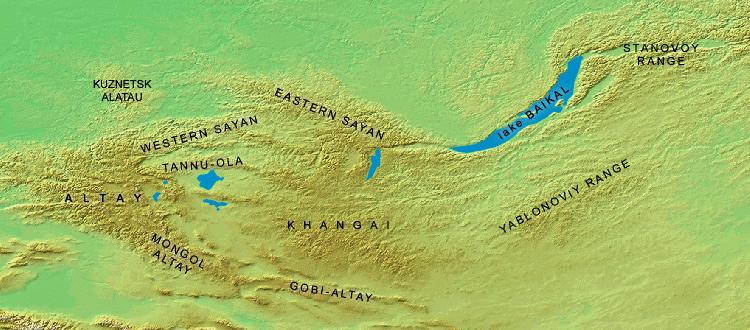
Map № 9. Location of the Argun River within the Amur Basin
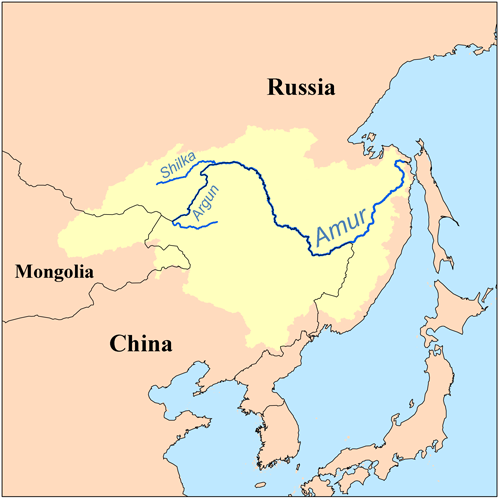
Map № 10. Russian-Chinese Frontier (Nerchinsk Treaty, 1689)
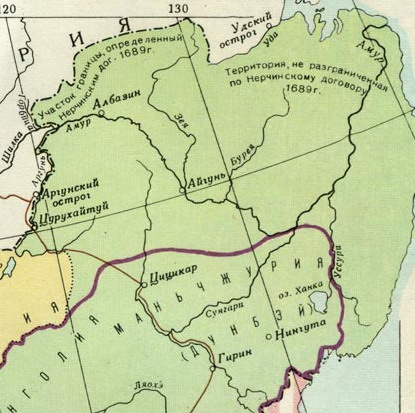
Map № 11. Russian-Chinese Frontier (Nerchinsk Treaty 1689)
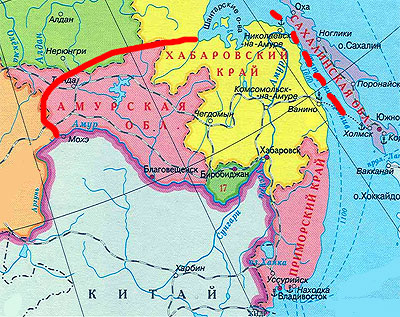
Map № 12. Bering’s voyage
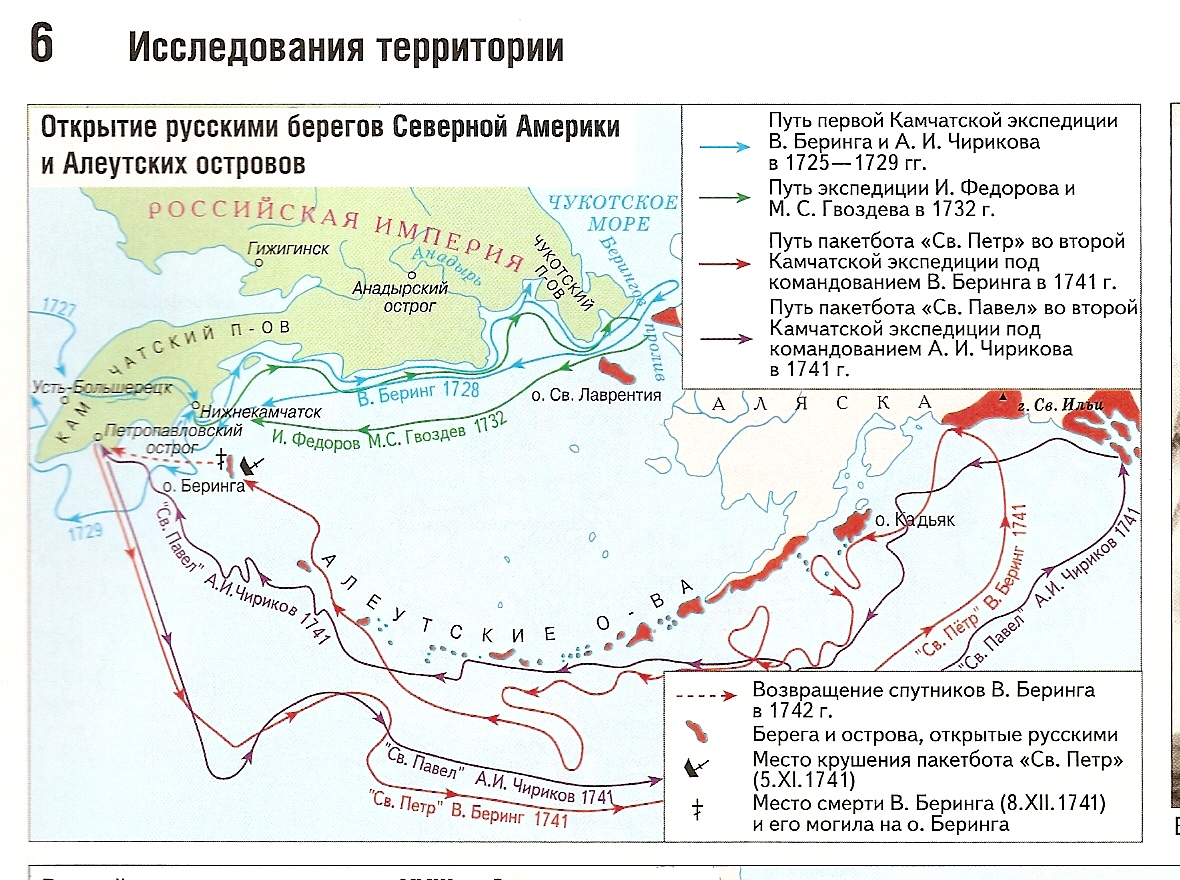
Map № 13. Bering Strait
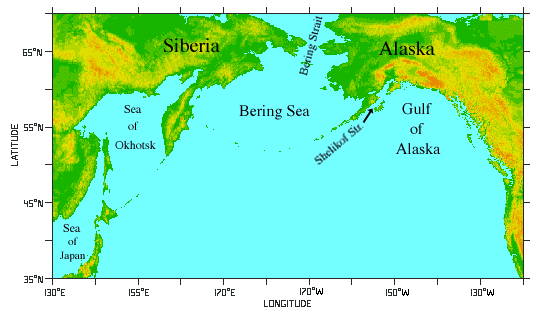
Map № 14. The First People in America
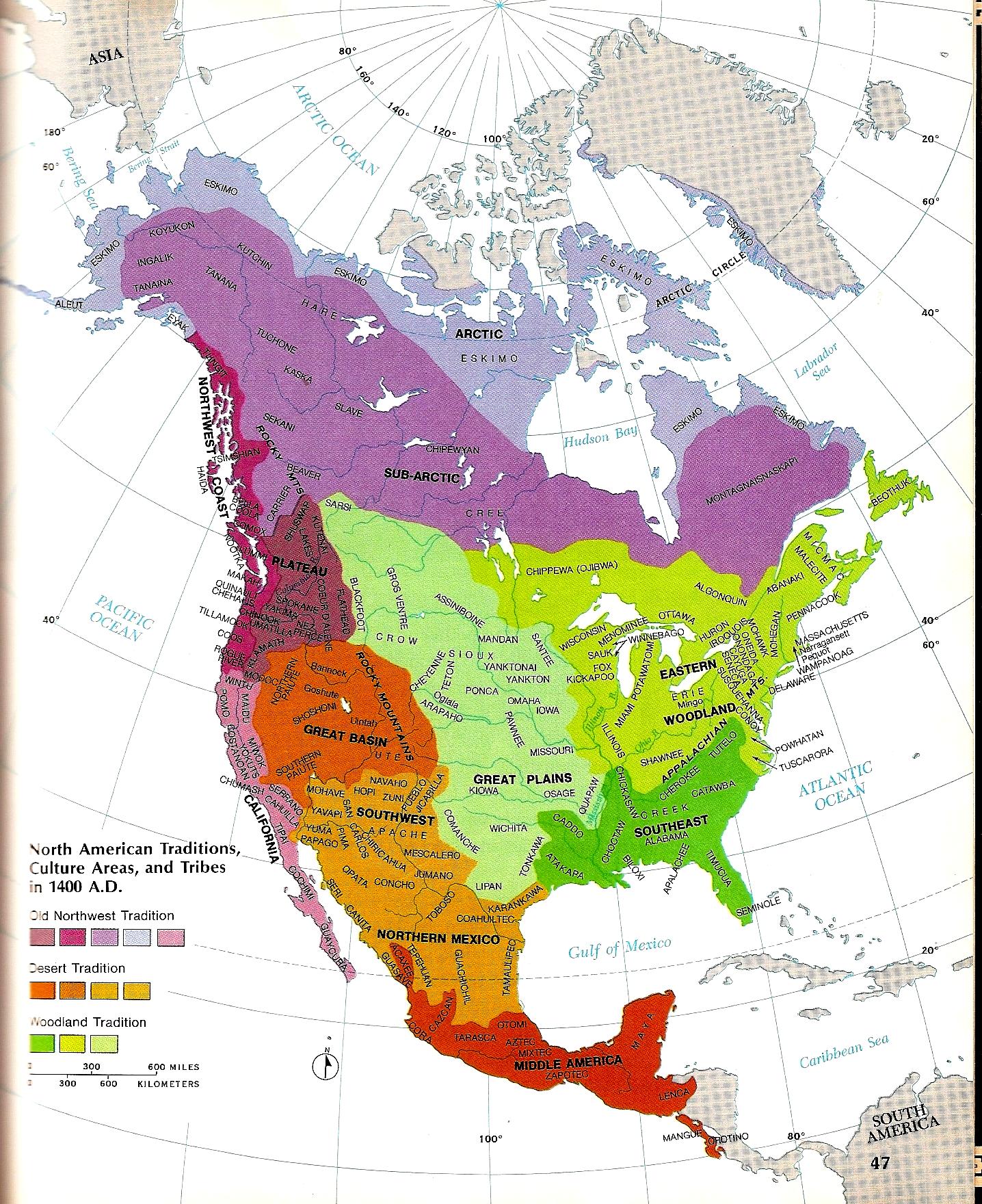
Map № 15. Russian America
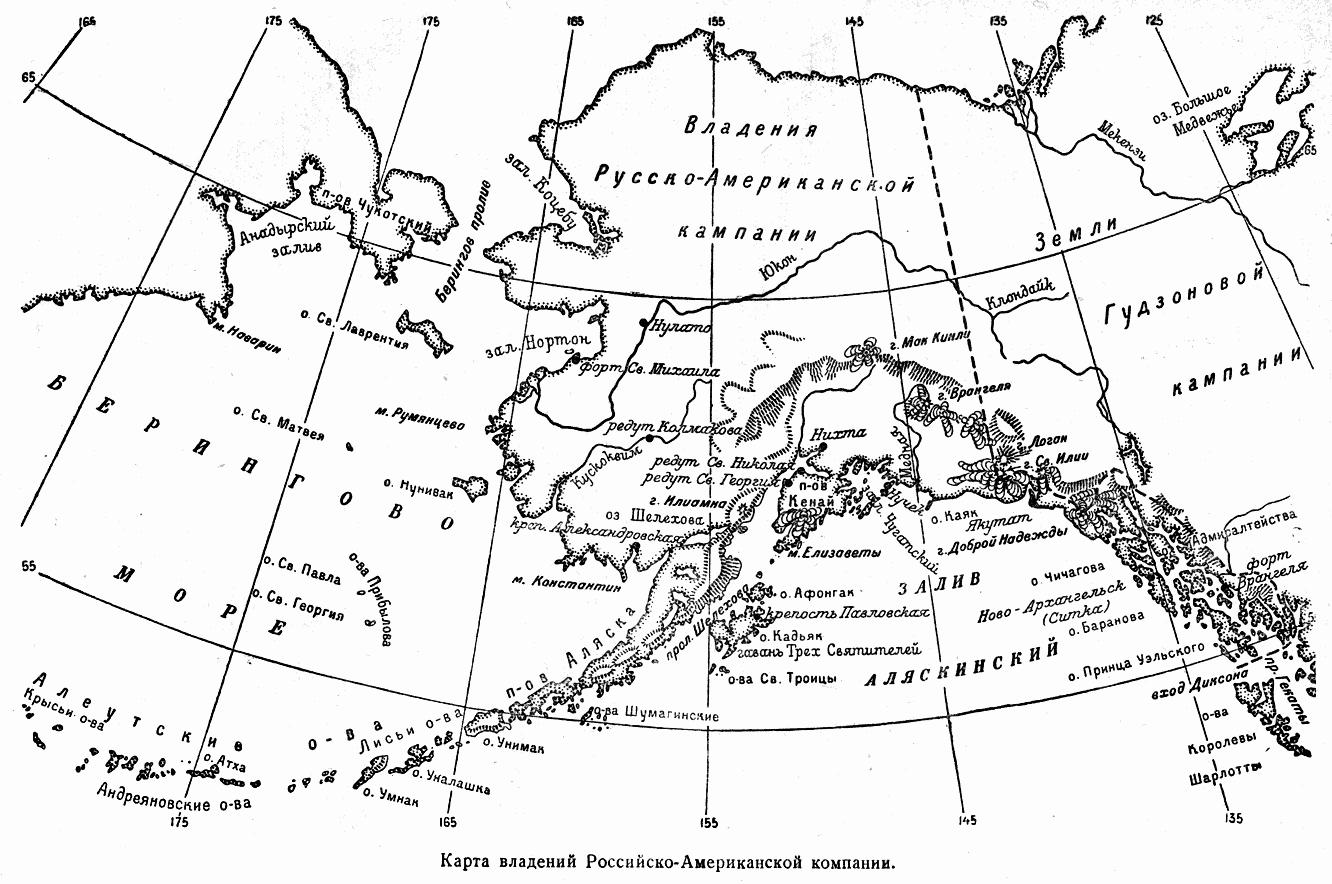
Map № 16. Russian America
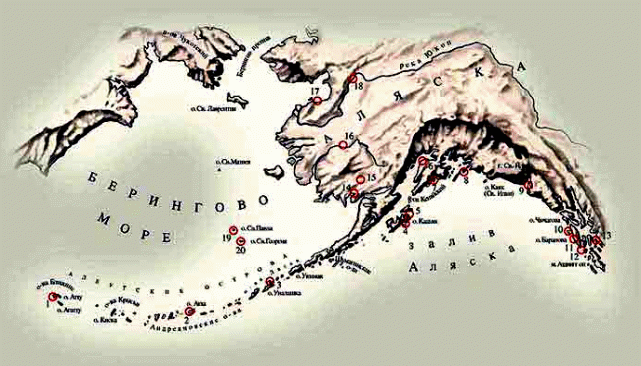
1 – селение Порт Чичагов на Острове Атту; 2 – селение Атхинское (год основания 1795) на оcтрове Атха – центр Атхинского отдела Русской Америки; 3 – селение Гаванское, позднее Доброго Согласия, Иллюлюк, Уналашка (1800 год) – центр Уналашкинского отдела Русской Америки; 4 – крепость Трехсвятительская (1784 год) на оcтрове Кадьяк; 5 – Павловская гавань (1792 год) на о. Кадьяк – центр Кадьякскaго отдела Русской Америки; 6 – Николаевский редут (1786) в заливе Кука; 7 – Воскресенская гавань (1793) на Кенайском полуострове, нынче город Сьюард, названный в честь государственного секретаря США, обеспечивавшего покупку Аляски в 1867 году; 8 – крепость cвв. Константина и Елены, позднее Константиновский редут (1793) на оcтрове Нучек; 9 – крепость Якутат и селение Славороссия, позднее Новороссийск (1796); 10 – крепость Св. Архистратига Михаила, позднее Михайловская крепость (1799); 11 – Ново-Архангельск (1804) – административный центр Русской Америки и Ситкинскaго отдела на оcтрове Ситка (позднее оcтров Баранова); 12 – Озерский редут (1810) на острове Ситка; 13 – Дионисьевский редут (1819) на оcтрове Врангеля; 14 – Ново-Александровский редут (1819) в Бристольском заливе; 15 – Нушагакский поселок (1835); 16 – Колмаковский редут (1841) на реке Кускоквим; 17 – Михайловский редут (1833) в заливе Нортон; 18 – поселение Нулато (1839) на рeке Юкон; 19, 20 – промысловые селения на оcтровах Св. Павла и Св. Георгия. Кроме того, в Русскую Америку входили Форт Росс (1812) – центр Российского отдела Русской Америки (недалеко от Сан-Франциско) и Курильский отдел с центром на острове Уруп
Конец формы
Map № 17. Rout of G.I. Nevelskoy
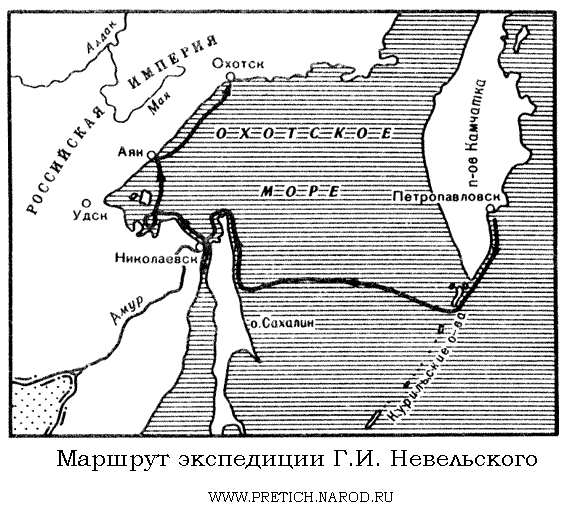
Map № 18. Location of the Port Dalny
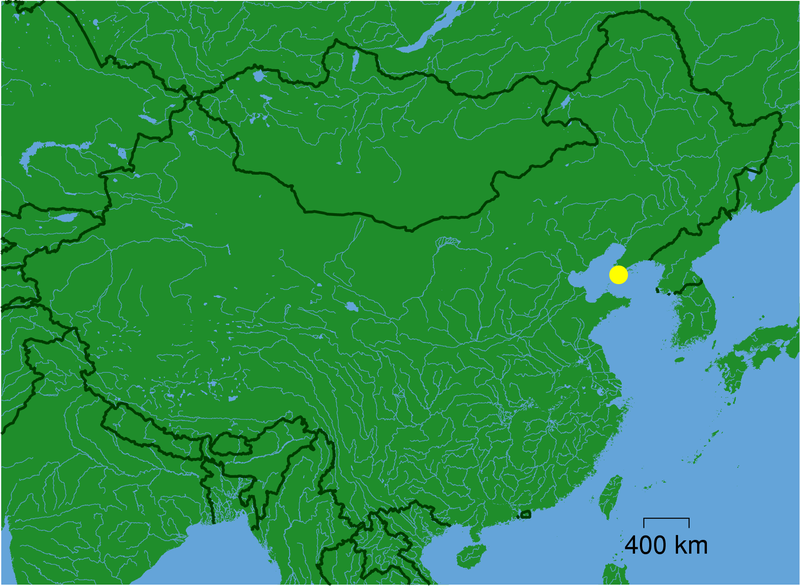
Map № 19. Harbin
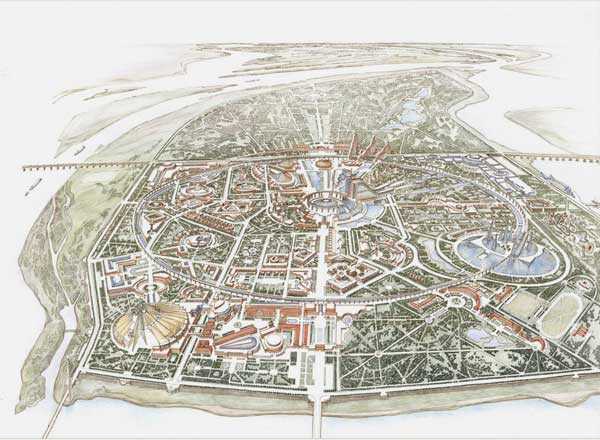
Map № 20. Expeditions of V.K. Arsenev
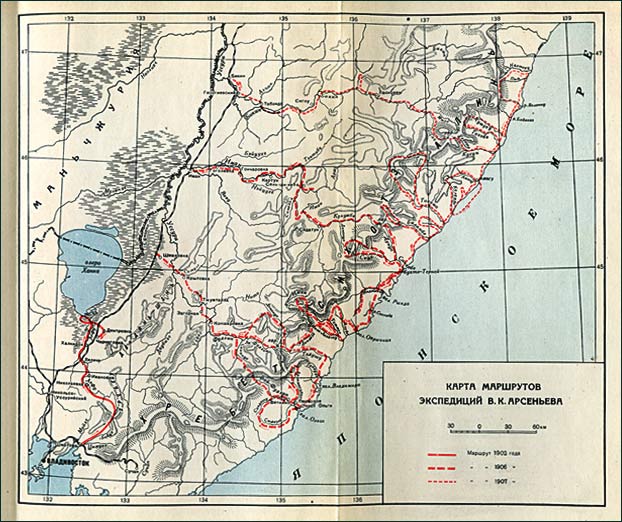
Map № 21. Topographical plan of Khabarovsk
made by the Surveyor M. Lubensky in 1864
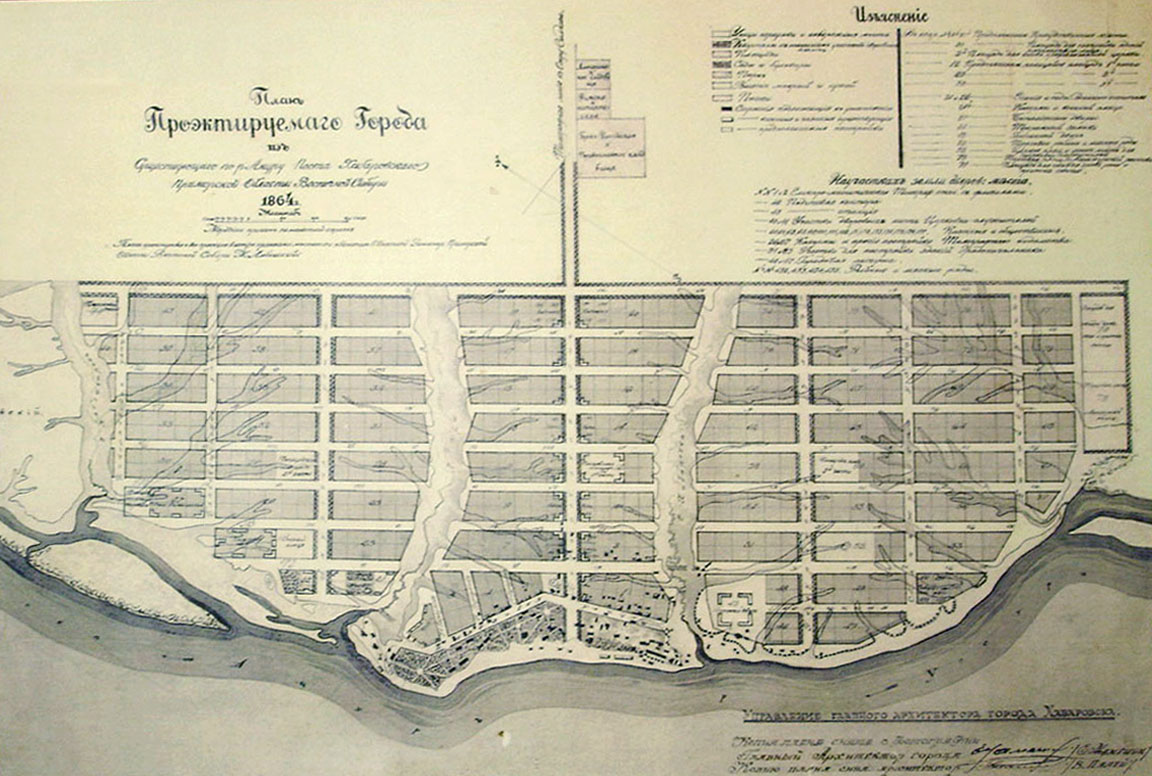
Map № 22. Modern Khabarovsk
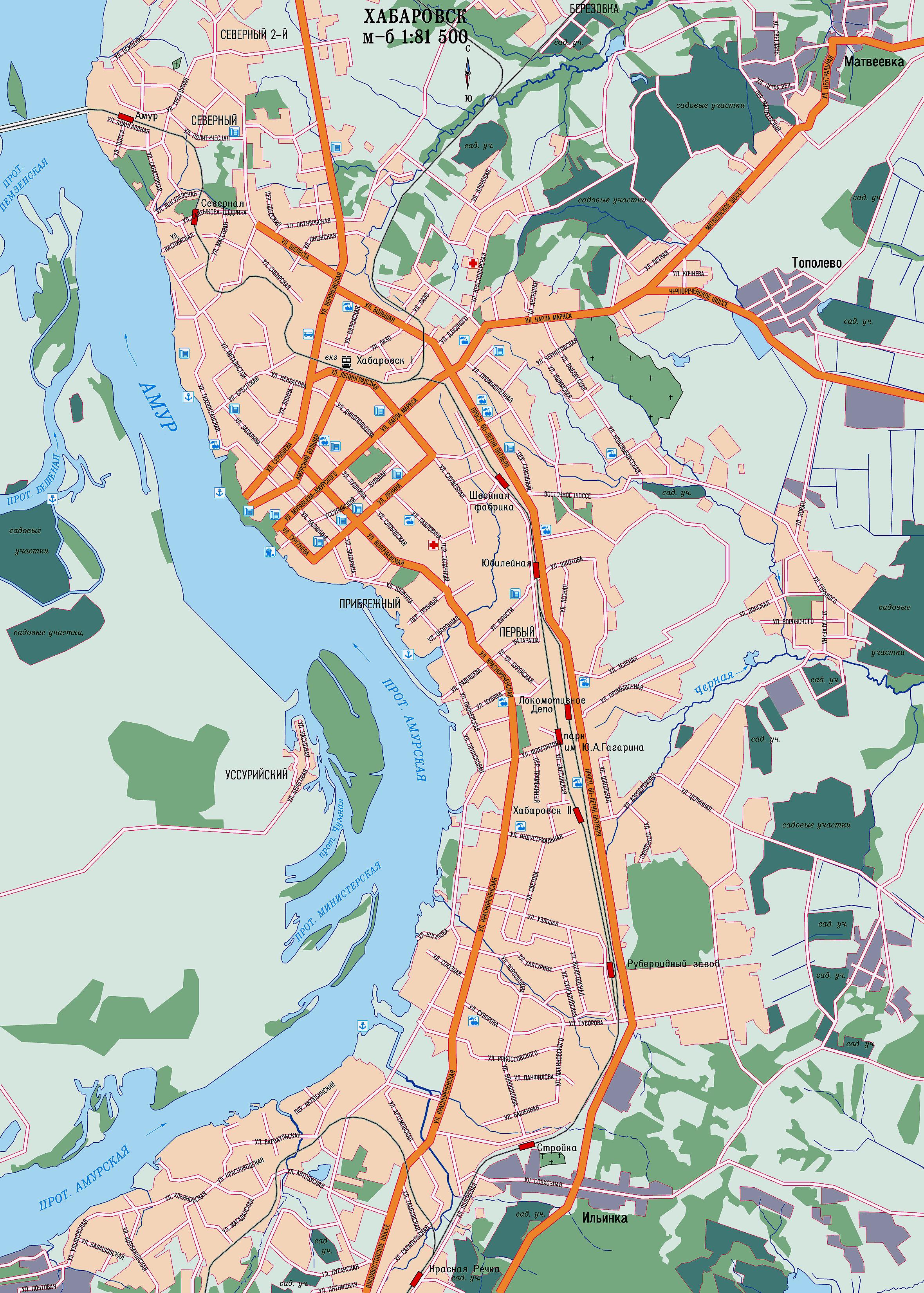
Map № 23. Amur River
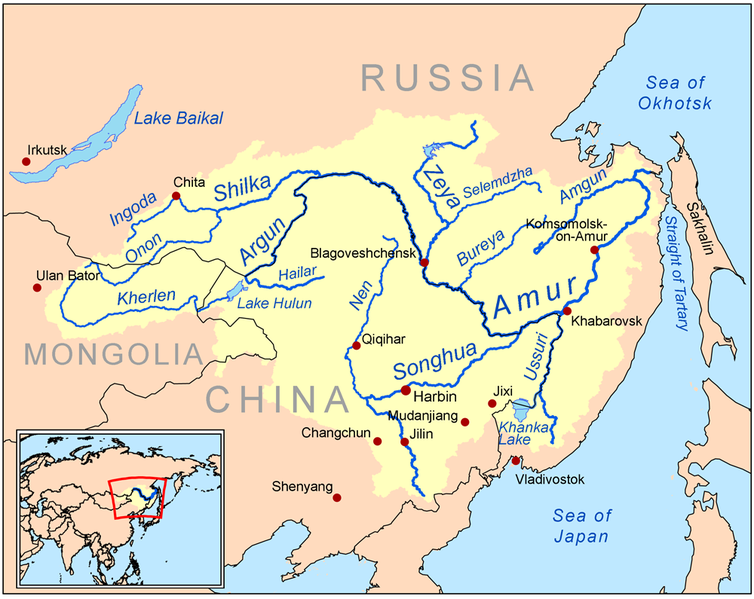
Map № 24. Khabarovsk Territory
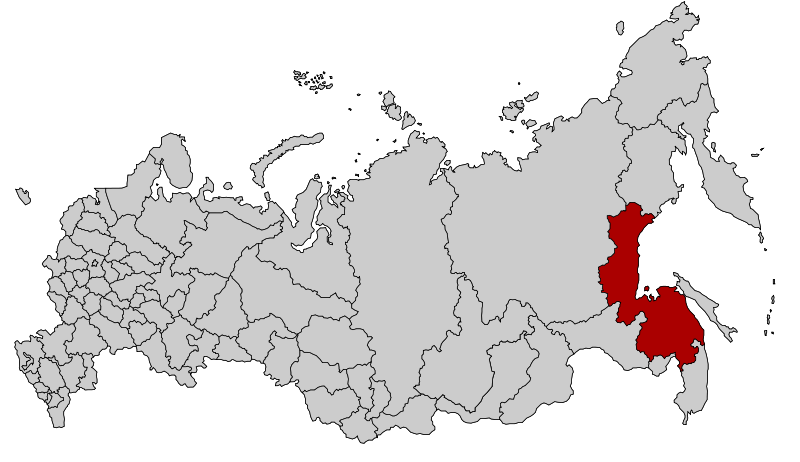
OLD BUILDINGS OF KHABAROVSK
1
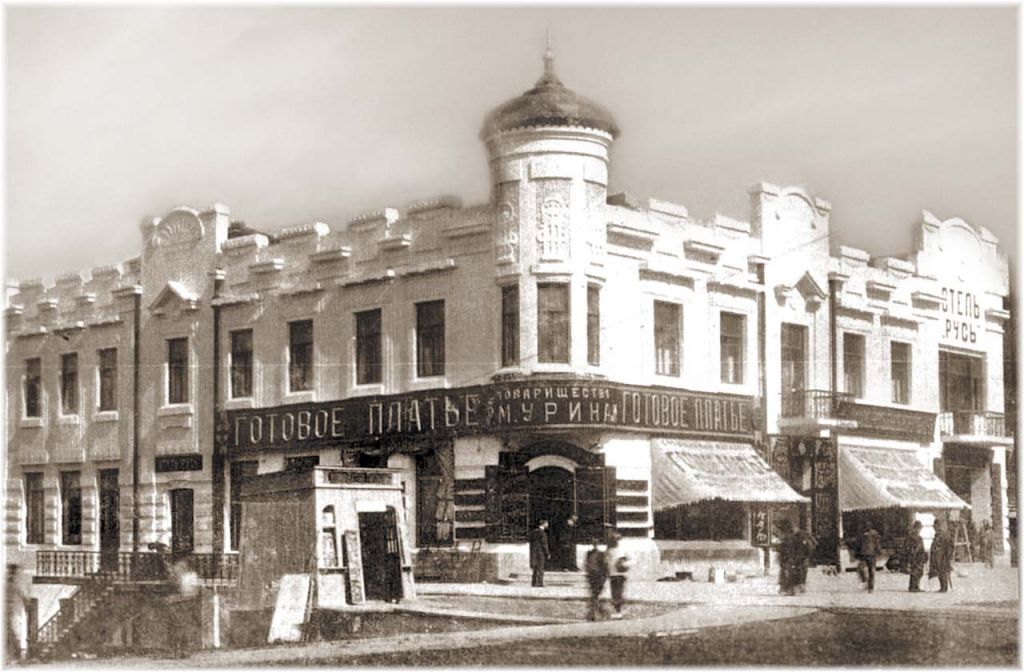
2
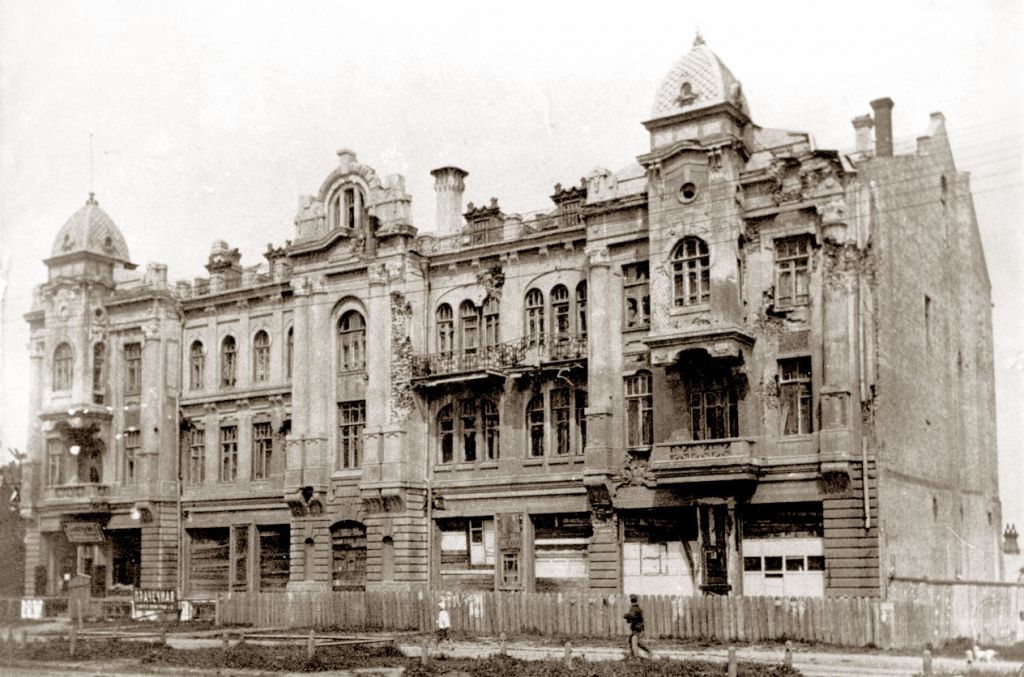
3
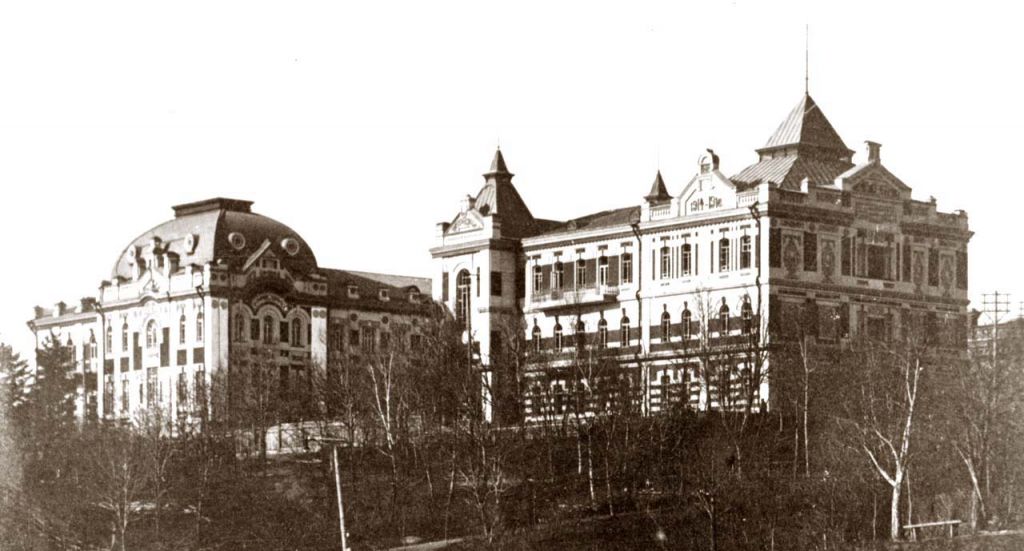
4
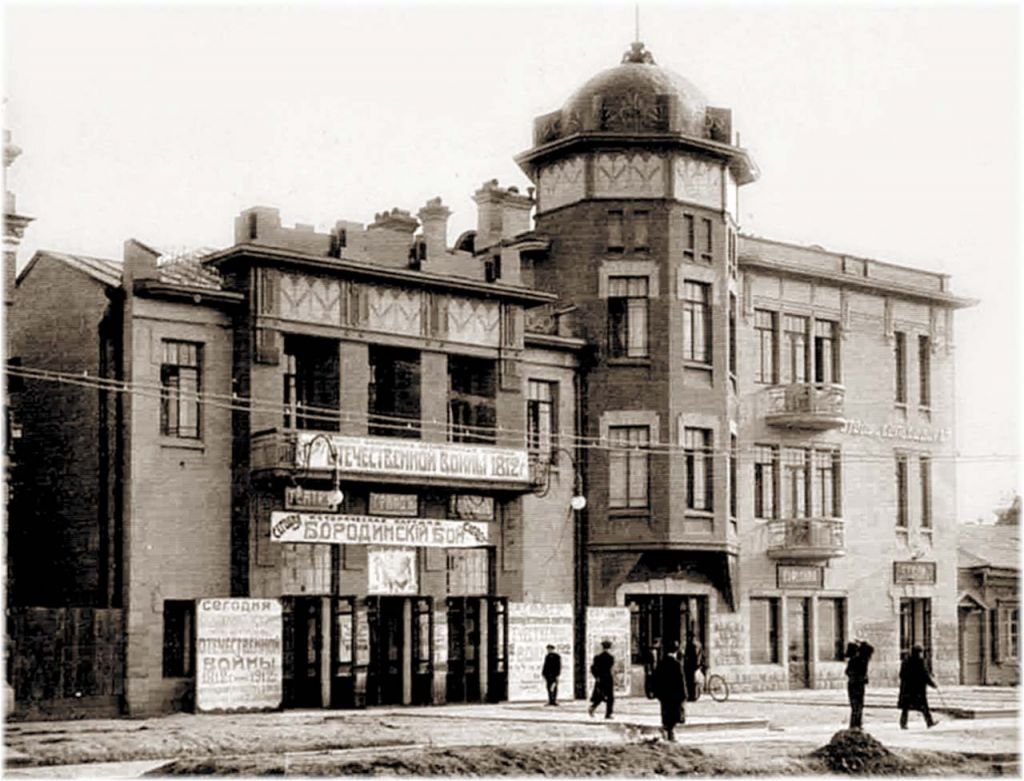
5
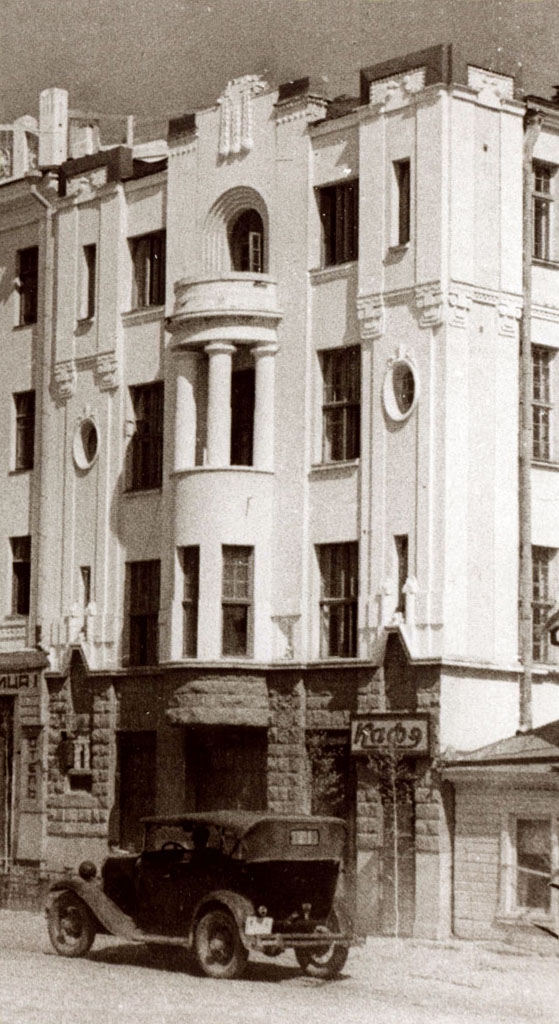
6
7
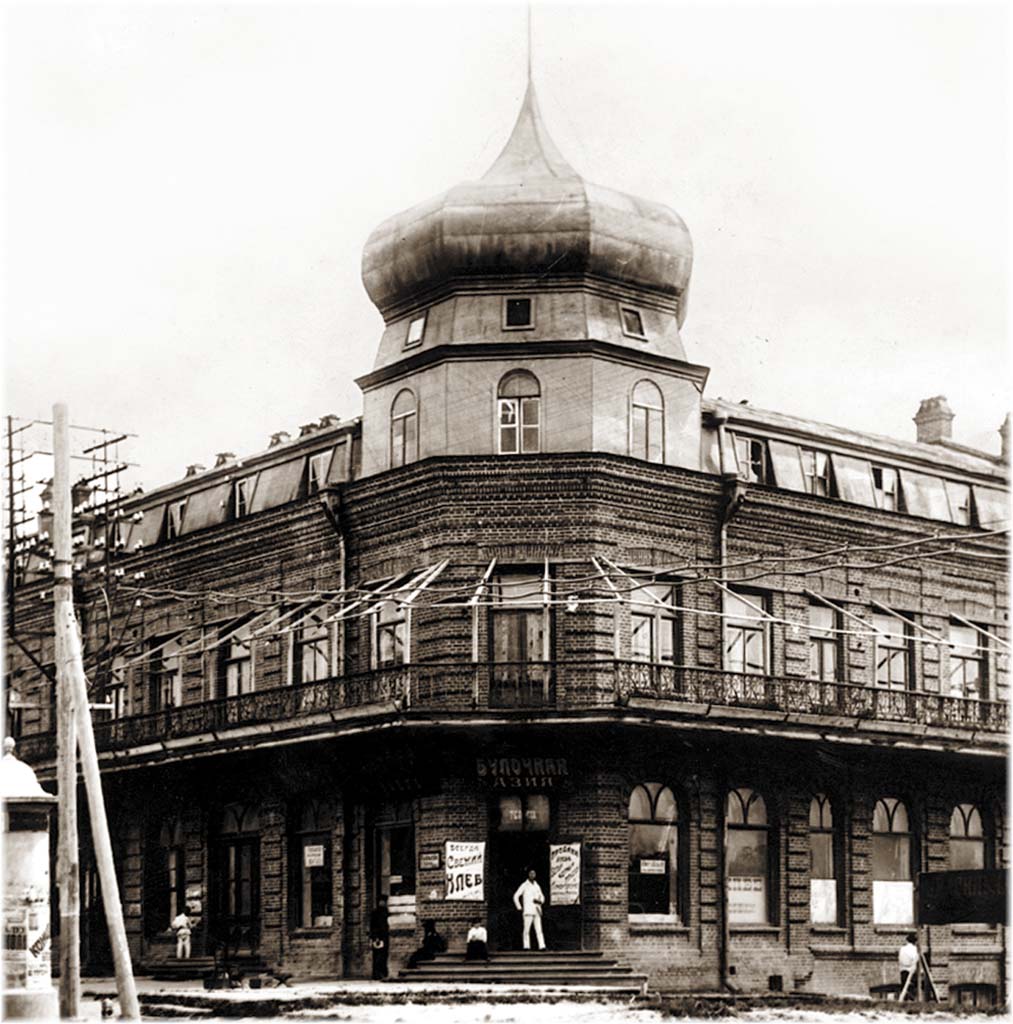
8
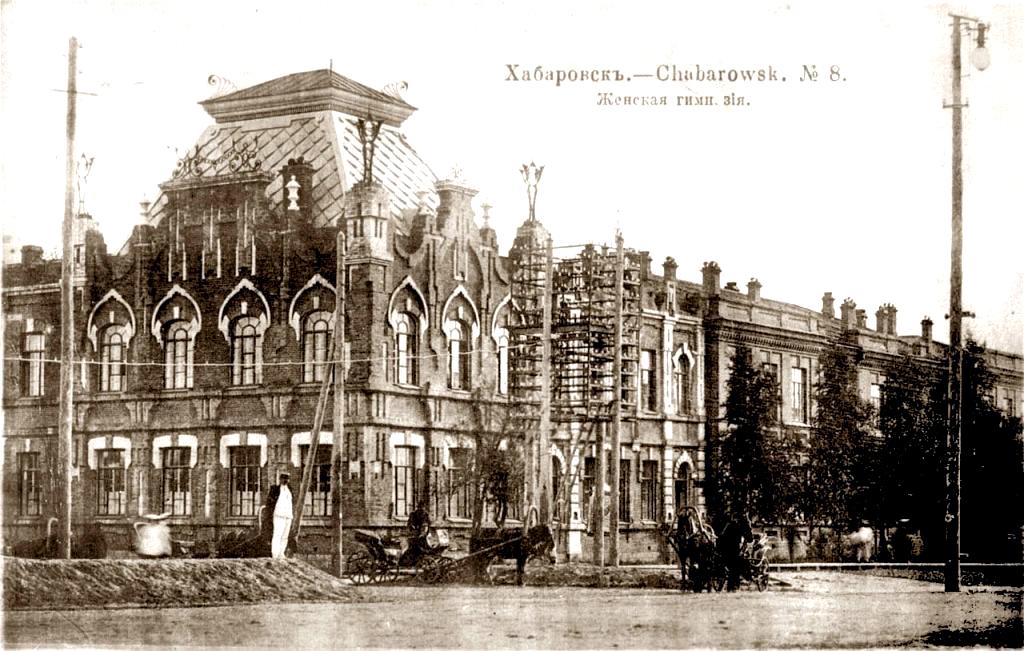
9
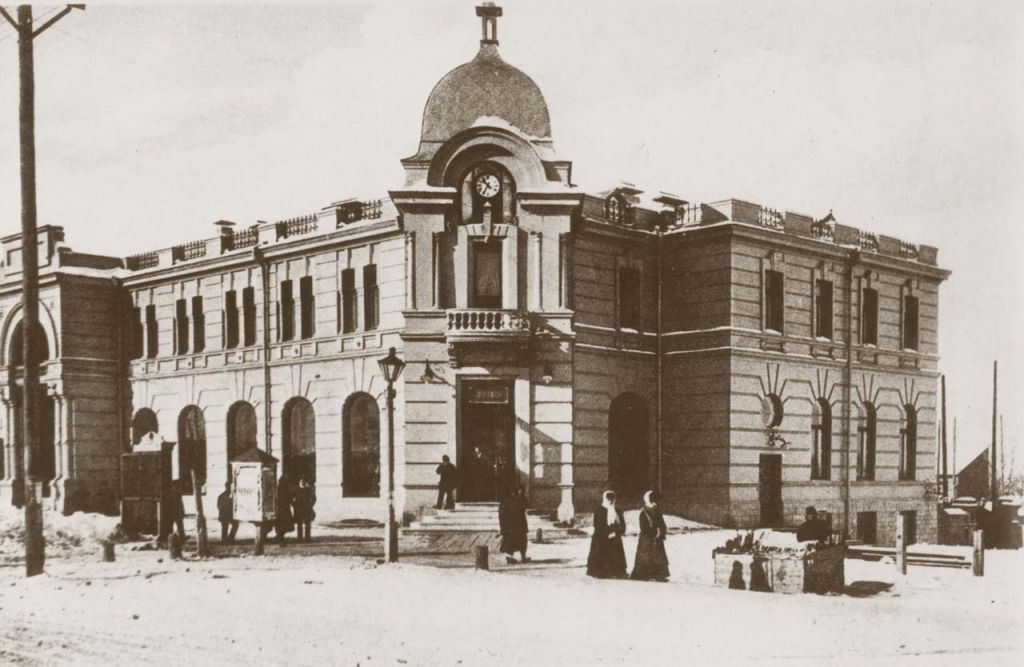
10

11
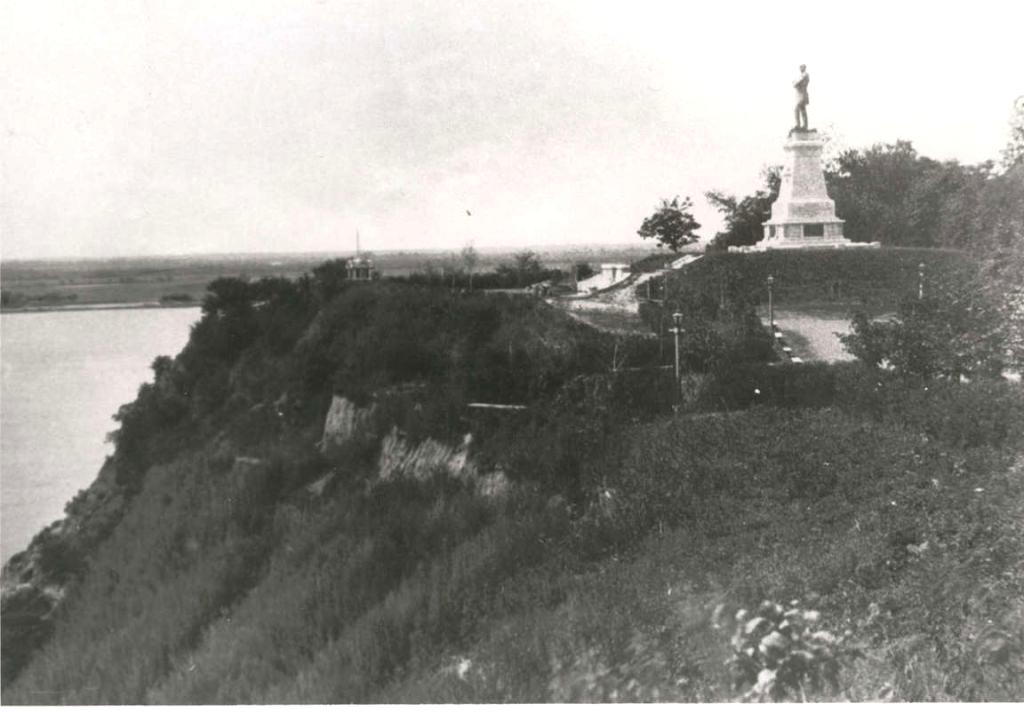
12
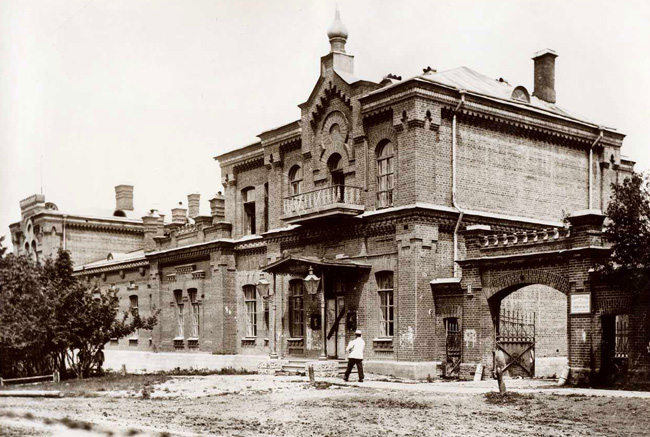
13
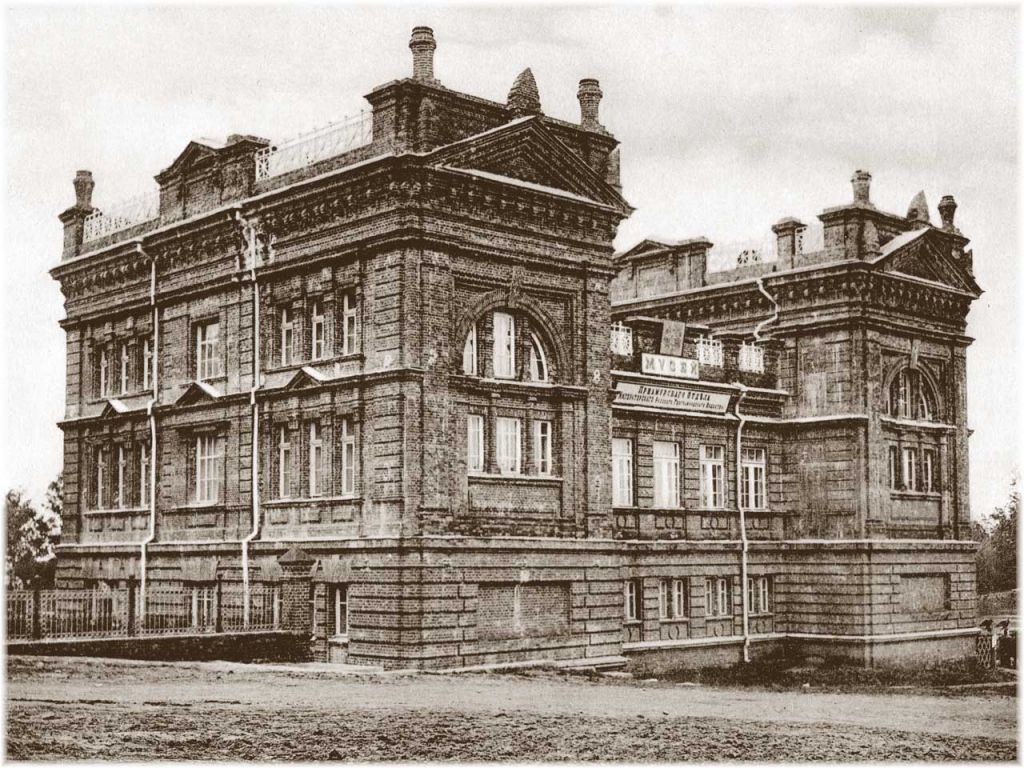
14
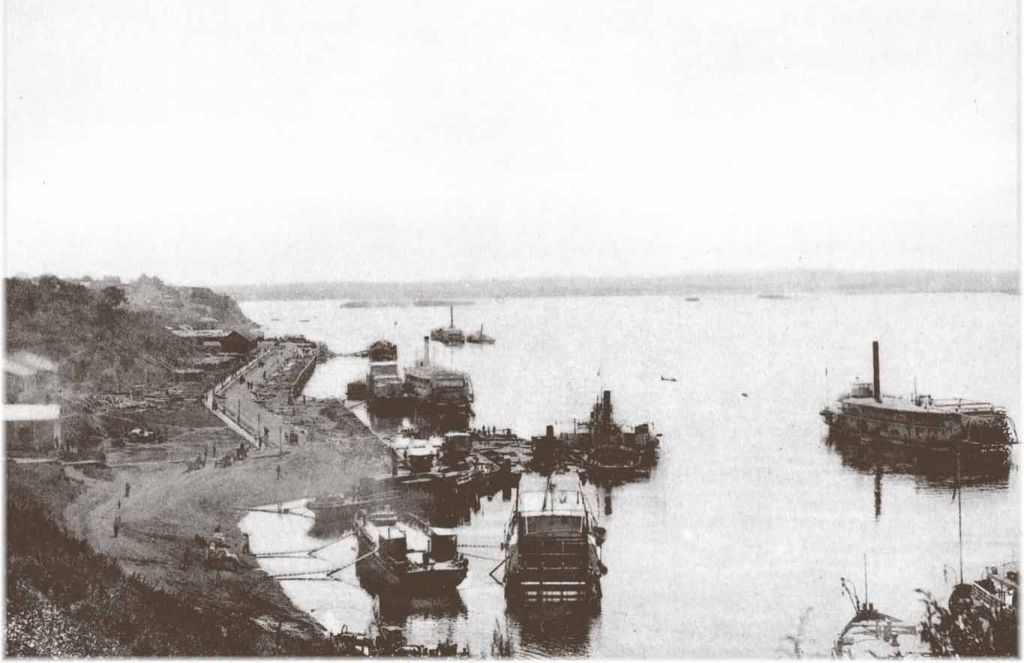
15
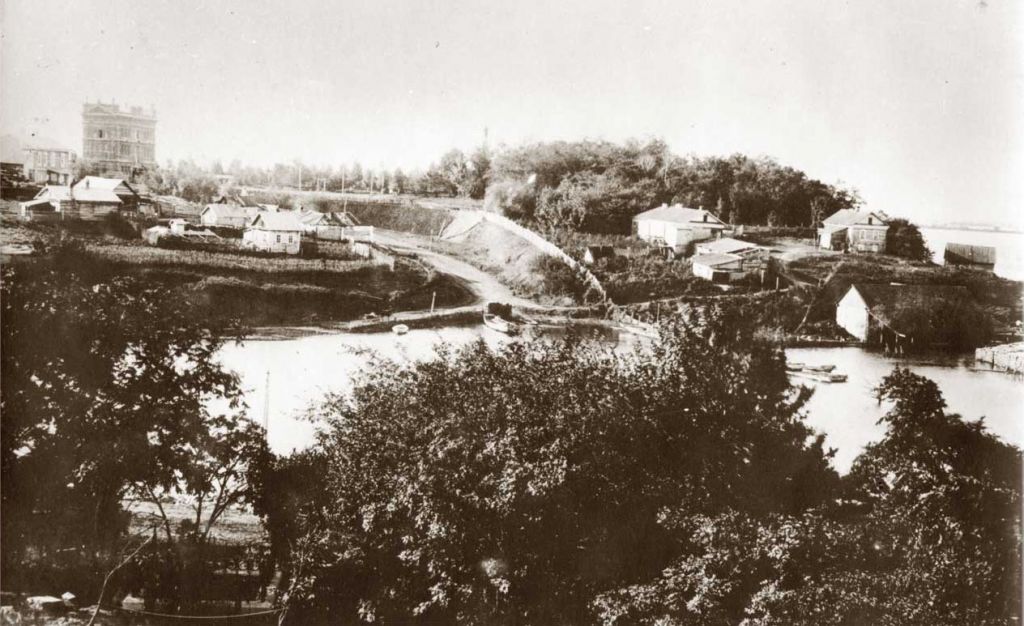
REFERENCE SOURCES
1. Ilyin, A.A. Khabarovsk Territory. Pages of History / А.А. Ilyin. – Vladovostok : Publishing House ”Utro Rossii”, 1996.
2. Ilyin, A.A. Towards the sun / А.А. Ilyin. – Vladovostok : Publishing House ”Utro Rossii”, 1998.
3. Бурилова, М. Хабаровск купеческий / М. Бурилова. – Хабаровск : Издат. дом "Приамурские ведомости", 1998.
4. Чагин, В.В. Здесь начинается Россия / В.В. Чагин. – Красноярск : Платина, 2008.
5. Пчелов, Е.В. Государственные символы России / Е.В. Пчелов. – М. : ООО ПФ "Полиграфист", 2004.
6. Рыжов, К. Все монархи России / К. Рыжов. – М. : ООО "Издательство «ВЕЧЕ»", 2001.
7. Сафронов, Ф.К. Тихоокеанские окна России / Ф.К. Сафронов. – Хабаровск : Хабаровское книжное издательство, 1988.
8. Бессолицына, Т.С. Улицы Дальневосточной столицы / Т.С. Бессолицына. – Хабаровск : Издательство Хворова А.Ю., 2008.
9. Венюков, М.И. Путешествия по Приамурью, Китаю и Японии / М.И. Венюков. – Хабаровск, 1970.
10. Чернышева, В. Хабаровск: Очерк истории / В. Чернышева, Г. Чечулина, А. Сутурин. – Хабаровск, 1983.
11. Пржевальский, Н.М. На далеких реках : хрест. по истории Дальнего Востока. Кн. 1 / Н.М. Пржевальский. – Владивосток, 1982.
12. Приамурье. Факты. Цифры. Наблюдения. Приложение к отчету общеземской организации за 1908 год. – М., 1909.
13. Пензин, И.Д. Роль Хабаровска в развитии Дальнего Востока / И.Д. Пензин // Дальний Восток в контексте мировой истории: от прошлого к будущему : матер. междунар. науч. конф. (доклады и сообщения), 18–20 июня 1996 года. – Владивосток, 1997.
14. Болгурцев, Б.Н. Морской биографический справочник Дальневосточной России и Русской Америки XVII – начала XX вв. / Б.Н. Болгурцев. – Владивосток : Уссури, 1998.
15. Лебедева, И.М. Наш город и область: Век XX: Петербургская тетрадь по краеведению для учащихся основной школы. Ч. 4 / И.М. Лебедева, И.З. Захваткина, Л.К. Ермолаева. – Изд-я 3–5-е. – 2008.
16. Барсуков И. Граф Николай Николаевич Муравьев-Амурский : репринт. изд. по изд. Синодальной Типографии. М., 1891 / И. Барсуков. – Хабаровск : Риотип, 2008.
17. Дубинина, Н.И. Приамурский генерал-губернатор П.Ф. Унтербергер / Н.И. Дубинина. – Хабаровск : РИОТИП, 2008.
18. Бодиско, А.М. Из жизни Хабаровска / А.М. Бодиско. – Хабаровск : ДВГНБ, 2008.
19. Мастера кисти и резца : сб. док. Гос. архива Хаб. края об истории изобразительного искусства Хабаровского края. — Хабаровск : Издат. дом "Частная коллекция", 2007.
20. Пузаков, И. Амур: от истока до устья = The Amur from source to estuary / И. Пузаков. – Хабаровск : Приамурские ведомости, 2008.
21. Чернова, Н. Экология реки Амур : дайджест ДВГНБ / Н. Чернова. – Хабаровск : ДВГНБ, 2008.
22. Крадин, Н.П. Памятники архитектуры Хабаровска / Н.П. Крадин. – Хабаровск, 1996.
23. Крадин, Н.П. Охраняются государством. Памятники архитектуры и скульптуры общероссийского значения в Хабаровске / Н.П. Крадин. – Хабаровск, 1999.
24. Крадин, Н.П. Архитектура и архитекторы Хабаровска / Н.П. Крадин. – Хабаровск, 2003.
25. Шарашова, М.К. Названия растений и легенды о них / М.К. Шарашова. – Хабаровск, 1971.
27. Сахаров, А.Н. История России С начала XVII до конца XIX века / А.Н. Сахаров. – АСТ, 2001.
Web-sites:
www.simon-dezhnev.biography.ms
www.win.tue.nl/~engels/discovery/dezhnev.html
